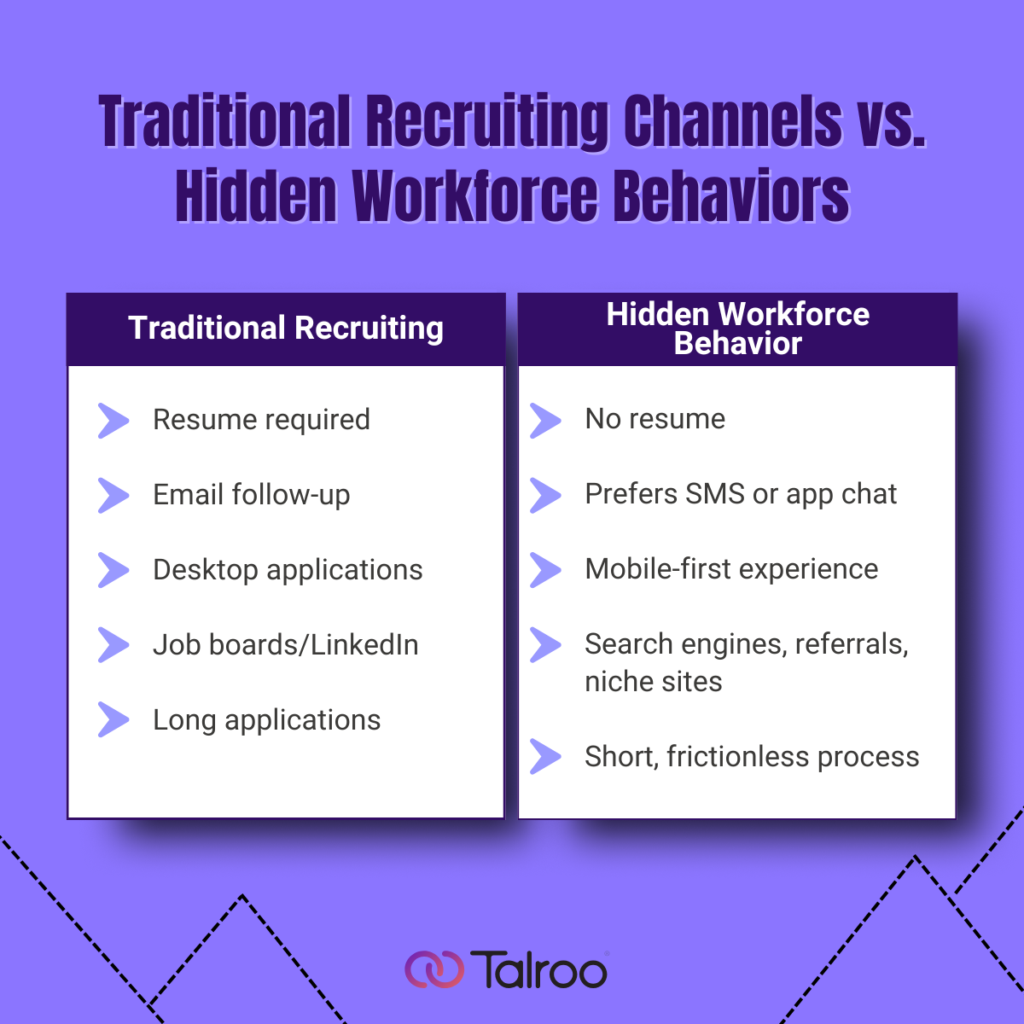
Reaching the Unreachable: Connecting with Non-Traditional Job Seekers
In the ongoing challenge of filling frontline and high-volume roles, a significant portion of the talent pool continues to go unnoticed. Just one example: more than 97% of Talroo’s frontline worker profiles are not active on major B2B-oriented networking sites. These are workers without polished resumes, who aren’t active on LinkedIn or traditional job boards, and who don’t follow the conventional job-seeking playbook. Yet, they are skilled, motivated, and ready to work.
This often-overlooked group is part of what’s now being called the hidden workforce and understanding how to connect with them is becoming increasingly essential for employers, especially those in industries like logistics, healthcare, retail, food service, and manufacturing.
Want to drill down into more frontline workforce data? Check out Talroo’s Frontline Worker Index | Q1 2025
Who Makes Up the Hidden Workforce?
The term hidden workforce refers to job seekers who are not visible through standard recruiting channels. This includes:
- Frontline and hourly workers who may not maintain traditional resumes
- People with employment gaps or non-linear career histories
- Individuals seeking gig, seasonal, or flexible work
- Skilled tradespeople who don’t engage with professional networking platforms
- Job seekers who prefer alternative communication channels like SMS or in-person referrals
These individuals are still actively looking for jobs, but their methods and expectations don’t always align with conventional hiring processes. Employers who rely solely on job boards or resume-driven applicant tracking systems risk missing this sizable segment of the workforce.
As Thad Price, CEO of Talroo, put it: “Too often, frontline and skilled workers are overlooked because they don’t have a traditional resume—but that doesn’t mean they aren’t qualified.”
Why Traditional Recruiting Channels Fall Short
Many traditional recruiting strategies are built around the “almighty resume” and the idea that applicants will find job postings on large job boards or corporate websites, apply with a resume, and follow up via email. This works well for corporate and white-collar roles, but not so much for frontline or non-traditional candidates.
Here’s where traditional methods often fall short:
- Job seekers are mobile-first: Many candidates in frontline roles rely on their phones to search and apply for jobs, preferring text over email.
- They don’t use resumes: Instead of a resume, many prefer to apply by answering a few questions or highlighting prior work experience in plain language.
- They’re not on LinkedIn: Professional networking sites don’t always cater to those in hourly, part-time, or gig work.
- Speed matters: Long application processes and slow response times can push candidates toward more responsive employers.
If hiring systems don’t adapt to these realities, employers will continue to struggle to fill open roles, despite an active and willing labor force.
Where Non-Traditional Job Seekers Are Looking
So where exactly is the hidden workforce looking for jobs, if not on traditional sites? Research and industry data point to several key channels:
- Search engines: A high number of candidates start with searches like “jobs near me” or “immediate hire warehouse jobs.”
- Niche and vertical job platforms: Industry-specific sites often attract targeted audiences for roles in trucking, caregiving, construction, and more.
- Mobile apps and social media: Platforms like Facebook groups, community forums, and mobile-first job apps are increasingly popular for job discovery.
- Referrals and local networks: Word-of-mouth and community-based recommendations still play a large role, especially in rural or tight-knit communities.
- Text and chat-based interactions: Candidates are more responsive when recruiters or systems initiate contact via SMS or messaging apps.
The common thread across all of these platforms is accessibility and simplicity — features that traditional systems haven’t always prioritized.
Making the Connection: Strategies for Reaching the Hidden Workforce

To effectively reach and engage these non-traditional job seekers, employers need to realign their hiring practices. Here are a few strategies that have proven effective:
1. Simplify the Application Process
Avoid multi-page applications or requiring resumes for entry-level and frontline roles. Use short forms, mobile-friendly applications, or even “easy apply” options that allow candidates to express interest quickly.
2. Optimize for Mobile
Assume that the candidate is on a smartphone. Ensure that your job postings, application process, and follow-up messages are mobile-optimized and can be completed in under five minutes.
3. Diversify your Sourcing
The hidden workforce can’t be found on traditional job boards and B2B social sites. Dedicate some of our resources toward niche job sites, social networks, and other out-of-the-box platforms.
4. Use Intent Data and Search Behavior
Target candidates based on their behavior, such as recent job searches or interaction with job content, rather than relying solely on resume databases or job board applications.
5. Incorporate AI-Driven Matching
AI tools that match candidate skills and experience to job requirements can help surface qualified individuals who don’t follow traditional job-seeking norms. These systems can also integrate with applicant tracking systems (ATS) to reduce manual sourcing.
6. Leverage Alternative Communication Channels
Text messaging, app-based chat, and even social media direct messages see far higher engagement rates among frontline job seekers than emails or phone calls. Speed and accessibility are crucial.
7. Focus on What Candidates Care About
Be upfront about pay, hours, benefits, and expectations. Candidates in frontline roles want to know what they’re signing up for without having to dig through jargon-heavy job descriptions.
Related: Digital Literacy For Frontline and Essential Workers
A Shift in Perspective
Reaching the hidden workforce isn’t just about better tools. It’s about changing how we think about candidates. Employers often undervalue applicants without formal resumes or traditional experience, despite their capability and work ethic.
It’s worth asking: Are your hiring practices designed to filter in qualified candidates, or filter them out?
By reconsidering what “qualified” means and designing hiring systems with the end user in mind, employers can unlock access to millions of overlooked workers — many of whom are actively seeking jobs but aren’t getting noticed.
Moving Forward: Connecting With the Hidden Workforce
The labor market is evolving, and so must recruiting strategies. Hiring teams that recognize the value of non-traditional job seekers and adopt data-driven, candidate-first approaches will be better positioned to fill roles quickly and build more inclusive, effective workforces.
Connecting with the hidden workforce starts with visibility, but success comes from accessibility, speed, and understanding how real people search for jobs today.
Ready to tap into the 97% of job seekers you’re not seeing? Contact Talroo today and discover how we’re helping employers like you find, attract, and hire the hidden workforce.




